|
| |
| |
| |
The influence of Erasmus' Enchiridion on Bruegel's Seven virtues
by Irving L. Zupnick
Allowing for the obvious differences between literature and the visual arts, Erasmus exerted considerable influence upon the painting of his own times. He came into personal contact with Quentin Massys, Albrecht Dürer, and Hans Holbein the Younger; but what is more important is that he helped to shape the ethical and moralistic tenor of his time, predisposing the artists of the North to accept his literary themes as subjects for art. I shall try to demonstrate that his influence was still operative in the second half of the sixteenth century, particularly in the case of an important work by Pieter Bruegel.
His more direct contact with art, as a sitter for portraits, reveals that even the intensely moralistic sage from Rotterdam was human, and not immune from the vice of VANITAS. He seems to have been more than pleased at Quentin Massys' interpretations, one painted in 1517 as part of a diptych that included a portrait of Petrus Aegidius, as a gift for Sir Thomas More, and another, modeled in relief on a medallion in 1519, which was sent to Willibald Pirckheimer. In contrast, he seems to have been a little uneasy about Dürer's ability, worrying about the time elapsing between the first sketch in 1520, and the completion of the engraving in 1526, afraid that Dürer, not having seen him recently, would make him too fat; and finally, if we can judge from Panofsky's interpretation of his rather formal and not overly enthusiastic eulogy of the artist, he was not too pleased. The younger Holbein, who illustrated a copy of the PRAISE OF FOLLY in 1515, portrayed him several
| |
| |
times, in one case in 1523, as Hecksher has shown, acting as Erasmus' propagandist, and using inscriptions to parallel his edition of the New Testament to the Labours of Hercules, and to score the brashness of critics.
Marlier has carefully documented Erasmus' influence on his friend Quentin Massys, and upon other artists who spent their formative years in Antwerp. Erasmus' strong attraction to the writings of Saint Jerome, which he brought out in two editions, seems to have been instrumental in changing the iconography for depicting the patron saint of scholars. Earlier the Saint had been portrayed as a hermit in the wilderness, or as a scholar, lion at his feet, hard at work in his study. The new iconography, probably introduced by Quentin Massys and used by his son, Jan, by Dürer and Lucas van Leyden when they were in Antwerp in 1521, and by Marinus van Reymerswael and Jan Sanders van Hemessen, shows Jerome contemplating the immanence of death, the Day of Judgement, and the hope of Eternal Life through Christ.
Within the same circle of artists, the PRAISE OF FOLLY, the COLLOQUIA, and other works of Erasmus, helped to shape moralistic genre painting in the period that preceded Bruegel's. As an example, the BANKER AND HIS WIFE in the Louvre, signed and dated in 1514 by Quentin Massys, suggests the moralistic tone established in the ENCHIRIDION, in which Erasmus dwells upon the relative, sometimes tenuous, distinction between industry and avarice. The painting now lacks its former frame, which, as late as the eighteenth century, bore the inscription, ‘Statura justa et aequa suit pondere’ (‘Just weights and just balances shall ye have’), which was an essential clue to its meaning. Within the painting itself, the mirror in the foreground makes a pointed contrast between the woman's proclivity to stray from the sacred Word, and the reflected man's complete absorption in his book. The inscription's reference to weights and balances called attention to a second, unused balance, which, significantly, hangs on a shelf next to a rosary. Wormald has accumulated a number of literary references that identify the balance as a symbol of the crucified Christ; and the rosary is usually symbolic of the Madonna. Quentin's painting then, seems to make the same comment as the ENCHIRI- | |
| |
DION, telling us that we should keep a just balance in our lives, and not let material preoccupations distract us from spiritual ones. Marinus van Reymerswael, who specialized in depicting variants on this composition, seems to have created a related type, showing tax-collectors, financiers, usurers, and notaries, confronting either the observer outside, or victims within, the picture, and making the implicit contrast between industriousness, in the person of a conscientious bookkeeper, and avarice, as personified by a snarling man who dictates to him. In addition, there are several other subjects which we would have to consider as Erasmian, because his writings made
them a prominent part of the cultural milieu which produced them. As examples, we suggest the ILL-MATCHED COUPLE in the Pourtales Collection, and the HYPOCRITES in the Palazzo Doria in Rome.
It should not surprise us that an intellectual collossus as great as Erasmus should influence his contemporaries; but what of his influence on later generations? To answer this question, we shall consider a specific example, an important project developed by Bruegel, which has proven to be controversial because of its ambiguity. This is the series, THE SEVEN VIRTUES, which he drew for engravings in 1559 and 1560, at a crucial time in his career, when he was turning away from his dependence upon Bosch, and finding his own imagery in the popular literature of his day.
Bruegel's representation of the Virtue, FAITH, from this series, is typical. As in the other six drawings, a personification of the Virtue, identified by attributes culled from mid-fifteenth century book illuminations, stands in the central foreground of the composition. She is surrounded by illustrative scenes, which, one would expect, should show the Virtue in practice; however, there are a number of apparent contradictions. Over forty years ago Tolnay pointed some of these out, suggesting that Bruegel was illustrating a paradox. Since then, many scholars have either ignored or refuted his astute observations, which, I hope to show, were more than justified.
There are some considerations which lend general support to Tolany's view. For one, if the VIRTUES are an expression of man's potential for goodness, they stand out like the proverbial ‘sore
| |
| |
thumb’ among Bruegel's other works in which he constantly reveals the characteristic pessimism of a conscientious social critic. Secondly, since even Tolnay's critics accept some of the drawings as satirical, it is legitimate to argue that the series should maintain a constant point of view throughout. Finally, the series belongs to a phase in Bruegel's development when he would have been most apt to experiment with the idea of using the paradox, which then was a literary device at the height of its popularity. A year earlier, in 1558, in the ALCHEMIST and EVERYMAN, he had signalled his liberation from the shadow of Hieronymus Bosch, and he was most receptive to literary concepts that could lend themselves to realistic pictorial imagery. The paradox had long since been popularized by THE PRAISE OF FOLLY; and I rather suspect that Erasmus' ENCHIRIDION, or THE HANDBOOK OF THE CHRISTIAN WARRIOR, provided the primary source of inspiration for Bruegel's interpretation of the VIRTUES, for in this important treatise Erasmus continually makes the point that ‘In Christ all things are changed and their names reversed.’ Erasmus' argument is, that all popular man-made concepts of virtue are false and illusionary, and fall short of the true spirit of Christianity.
The paradox in the drawing, FAITH, is not indicated very clearly. It is not so much in the characterizations, or in the light humor of inattentive children and dozing adults. It is rather in the implications of the inscription on the engraving: I quote ‘Faith, particularly with respect to religion, is to be preserved above all, for God comes before, and is more mighty than, man.’ This innocuous-seeming definition agrees by implication with the ENCHIRIDION, for in that treatise the external practices and ceremonies of religion are described as so many diversions that take us away from Christ. The personification is surrounded by objects symbolic of Christ's ordeal, but because such a profusion and scattering of identifying elements is atypical of the series, we should not consider them as attributes of FAITH. They are material mementos of Christ's sacrifice, relics, as it were; and their presence here recalls that the worship of relics was frowned upon by Catholic as well as by Protestant reformers. The Seven Sacraments shown in the illustrative scenes are clearly indicative of Catholic worship, but we have
| |
| |
no reason to suspect, because of this, that Bruegel was any more anti-Catholic than Erasmus, who approved of the rites and sacraments, but condemned those men ‘who teach the people to put trust in these things when the ones that make us truly Christians are neglected.’ Bruegel would seem to agree with Erasmus that true faith is direct contact between the individual and his God, and that it has little to do with the worship of material relics, or the ceremonies that take one from baptism to burial.
In Bruegel's HOPE, the personification wears a beehive-tower for a headdress, holds a shovel and a scythe (all symbols of industry), and stands on the anchor of a sinking ship. Some survivors of shipwrecks appeal for deliverance; others swim desperately or cling to drifting spars. The other scenes show the same cleavage between action and prayer. Some prisoners pray; others take action, lowering a bottle from their window. Behind the prison, on a dock, a fisherman tends three lines while his family prays for his success. Behind this group some people try to contain a hopeless conflagration, but one man prays to a holy image. Stridbeck sees these divergent reactions as the contrast between the vita activa and the vita contemplativa, which each illustrate hope in their own way. Significantly though, Bruegel gives no indication of approaching salvation, as if to suggest that either variety of hope is the last resort for those who have nothing else. The inscription on the engraving tells us that ‘The assurance that hope gives us is most essential to an existence surrounded by so many nearly unsupportable woes.’ The personification stands on an anchor, and the anchor is faith, our only support in the turbulent seas of life. Bruegel seems to be linking these two theological virutes as Calvin does in writing that ‘Faith is the foundation upon which hope rests, hope feeds and supports faith.’ In comparison with the kind of hope that is anchored in faith, prayer for one's own physical salvation can be regarded as a form of selfishness, and as foolish as taking ‘arms against a sea of troubles.’ Usually, personifications of Hope carry a bird in a cage to symbolize restraint. In this case there is a free, unconstrained bird, possibly a falcon, perched on the prison bars. Does this bird, which is usually symbolic of envy or avarice, reflect upon the behavior of the people in the illustrative
scenes? Bruegel's
| |
| |
message then, would be in line with the contemplative literature of his times which tells us that neither desperate action nor selfish prayer is as virtuous as the kind of hope that expresses itself as a passive acceptance of Divine Will.
The inscription on the engraving of CHARITY tells us: ‘Expect that what is befalling others will befall you; you will be aroused to render aid only if you make your own the feelings of the man who cries for help in the midst of adversity.’ According to Tolnay, Bruegel's illustrative scenes depict a ‘perverted world,’ in which the poor are stripped naked and the starving are fed bread as hard as stones. He points out that no priest attends the poor man's burial, and that the truly needy prisoners in the dungeons are ignored by visitors who prefer to advertise their charity by visiting those in the fresh air. Stridbeck and Münz feel that Tolnay reads too much into these details; but there is other evidence. Mendicants seem to be seeking alms from a needy old couple, professional beggars seem to have beaten the more needy to the doled-out food, and the most gracious kind of charity seems to be that offered by an inn-keeper, who knows that his rewards will be more concrete and immediate. But most of all, we should remember, that if charity to beggars is considered a commendable virtue today, in Bruegel's lifetime it was more usually regarded with cold skepticism. Brant, Erasmus, Agrippa, and Luther, are among the many writers who describe beggary as a threat against society. In addition to their arguments that the penury and the hopeless afflictions of beggars were usually fraudulent and made fools of the givers, public display of generosity, as we see it in Bruegel's drawing, was open to the charge of hypocrisy, of trying to buy one's way into heaven. Saint Matthew clearly tells us, ‘Take heed that ye do not your alms before men, to be seen of them.’ The charitable folk can be seen either as fools or as self-advertisers, and not necessarily as people who are moved by the underlying sympathy and love for one's fellow man that are essential to this virtue.
The contrast between mankind's behavior and the abstract principle of virtue is much clearer in Bruegel's JUSTICE than it is in the theological virtues we have discussed. The inscription tells us: ‘The aim of law is through punishment either to correct him who is
| |
| |
punished, or to improve others by his example, or to protect the public by overcoming evil.’
The blindfolded personification wears a two-pointed headdress; the sort worn by prostitutes in the sixteenth century, according to Bax. The sword she holds is emphasized more than her empty, possibly unbalanced scales. The armed troops close by suggest that she represents unbalanced JUSTICE; severitas without liberalitas. This assumption is strengthened by the absence of any sign of mercy in the entire composition.
There is a dismal catalogue of punishments. Among them, a man about to be decapitated, prays to a crucifix. In the background a monumental cross rears up among gallows and torture wheels. We cannot see who it is that is impaled upon the cross and mourned by a man and a woman, as Mary and John mourned for Christ; but in later elaborations of an idea first expressed by Saint Bernard, all of the virtues were present when Christ was on the cross, ‘sed justitia in his locum non habet;’ that is, save justice.
Shields hanging on the wall at the left represent eight of the Lowland provinces, and their tilted position suggests subservience. The unexpected deer antlers on top of the chandelier could have been suggested to Bruegel by Aelian's queer book, ON ANIMALS, which went through an Antwerp edition only a few years earlier, in 1556. Aelian informs us that deer eat snakes. In the sixteenth century snakes symbolized evil, but specifically supplied a metaphor to describe lawyers as descendents of the subtle serpent of Eden who misdirected mankind. Further, Aelian tells us that when the stag has lost his antlers, he goes into hiding until he has regained his strength. The antlers may mean then, that injustice is unchecked when the forces for good are weakened.
PRUDENCE stands upon the ladder of spiritual aspiration. Her hat is a sieve, a sign of good judgement. The mirror is a means to self-knowledge, and the coffin shows awareness of the inevitable. The inscription says: ‘If you wish to be prudent, think always of the future, and weigh all conceivable outcomes;’ but in view of the preponderant tone of moralistic writings in this period, it is hard to imagine that Bruegel intended to link this virtue to material welfare, at least to the extent that it preoccupies the people in the illustrative
| |
| |
scenes. There is a contrast between those who exist only for the moment and those who hoard against the future. In the center one man stores gold in a chest, while another carries it about with him for daily use. The house with the hoarding family whose child saves his pennies, contrasts with a neglected house that has been shored up to prevent its total collapse. The thrifty family is also compared with a woman surrounded by empty pails, who cooks for present use, and whose lack of foresight is underscored by the accidental fire in her spare fagots. Behind this woman, a dying man confesses to a priest, but he has not thrown himself completely into God's hands. He has also hired a urologue in the hope of forestalling the inevitable. Brant's SHIP OF FOOLS argues that it is foolish to seek health ‘against heaven's will,’ because in his view illness was the result of sin. Therefore, except for the confessional scene, which probably represents piety long overdue, there is nothing to connect PRUDENCE with spiritual matters. The characters go their own selfish or careless ways; and apparently Bruegel's heavy emphasis upon material possessions is intended to deepen the contrast with the real meaning of the virtue. As in Erasmus' ENCHIRIDION, Bruegel attacks the ‘anxious solicitude for this constantly mutable life of shadows,’ and the lack of ‘thought for the life to come, which we must pass in everlasting wretchedness unless we provide for it with the greatest concern.’
FORTITUDE, which foreshadows the painting, Dulle Griet, seems incongruous in the series, because of its violence, and because the illustrative scenes are so patently unrealistic. The winged personification wears a cuirass, and supports a pillar of strength and an anvil that is hardened by blows. She stands upon a dragon whose tail is caught in a vise, and holds its leash in her hand. The dragon must symbolize mental and moral turpitude, if we are to judge from the inscription: ‘To conquer one's impulses, to restrain anger and the other vices and emotions; this is the true fortitude.’ It is probably no accident that the imagery recalls the attributes of Saint Dympna, who was invoked against insanity, and whose relics were kept in the church at Gheel, in Antwerp Province.
The action is in strong contrast with the inscription's appeal to self-restraint. In the foreground, soldiers, women, and a monk, are
| |
| |
vigorously destroying animals symbolic of the vices to which such classes of people were considered most prone. The violent scenes in the background utilize two motifs popularized in late medieval allegories. One of these, the representation of combat to reflect the struggle between good and evil, was the heritage of classical literature. The other, which uses the motif of a besieged castle as a metaphor of the defense, either of Christian principles, or of the individual soul, against the forces of evil, is familiar to all students of medieval literature. The relieving force of knights, some of whom charge behind a banner representing the crucified Christ, sweeps all before it. Their militancy has saved the fortress, but this does not mean that their effort was necessary, or that it was inspired by good intentions. In Erasmus' ENCHIRIDION ‘there is no clamor of war at all, but deathless peace and tranquility’ in the garrison's triumph. He tells us that ‘Nothing is more unlike anger than the thing which anger counterfeits, namely courage.’ The illustrative scenes seem to show the virtue in action, but perhaps they only seem to. Their violence in fact, is a contradiction of the true meaning of FORTITUDE.
The inscription for TEMPERANCE says, ‘We must see to it that we do not give in to empty pleasure, extravagance, or lustful living; but also that we do not live in filth and ignorance because of miserly greed.’ The ideas expressed here are consonant with the tradition that TEMPERANCE is the virtue of moderation, but they have little to do with the illustrative scenes. Suitably, the personification holds herself in check with a bridle and reins. She wears a clock for a headdress as a sign of reliability, and holds inverted spectacles to show that she can see clearly without them. She plants a spurred foot on the arms of a windmill to demonstrate control over a device that depends upon the winds of chance.
In contrast to all of these symbols of self-restraint, the Seven Liberal Arts as portrayed, are dedicated to excess and folly. Rhetoric appears as a dramatic performance under a banner decorated with an upside-down world. On the stage FAITH speaks to HOPE, but FOLLY enters from the wings. MUSIC is shown as a cacaphonous mingling of mismated sounds. PAINTING is represented by portraiture, which, according to a contemporary view, is
| |
| |
hack work that satisfies the vanity of the sitter. ARITHMETIC is demeaned because it is employed by tax-collectors or usurers; and its connection with acquisitiveness is underlined by the detail of a man who engraves his property mark on a set of bellows, perhaps in the hope that it will give him possession of the air. GRAMMAR is taught by a schoolmaster who holds a soup ladle and keeps a lash made of dry twigs in his belt; traditional symbols of prodigality and stupidity. Behind the students, DIALECTIC is represented by a group of theologians who all speak at once, while they turn their backs upon the Scriptures, the ultimate authority. GEOMETRY appears to be a dubious science. It helps to design lofty structures to the vanity of man, and, it is also noted, it can be applied in artillery ballistics as a means of destroying what has been built. Behind the geometricians, ASTRONOMY is represented by men engaged in fantastic projects, who are impious and foolish enough, as Erasmus says, ‘to investigate the dimensions, motions, and influences of the stars, or the hidden causes of things.’ Bruegel's anti-intellectualism here was anticipated in Erasmus' PRAISE OF FOLLY and Agrippa's ON THE VANITY OF ARTS AND SCIENCES; but in this drawing, where everything transpires simultaneously, the point is struck home, as it never could be in literary exposition, that the arts and sciences are at variance with one another and perhaps with the truth, and that there is something insular and perhaps absurd about their devotees.
As final evidence of the unity of the series it should be noted that Bruegel apparently was preoccupied with series of sevens.
| 1. | FAITH shows the Seven Sacraments. |
| 2. | HOPE may show seven perils connected with the pursuits of mankind (Shipwreck, drowning, being devoured as prey, fire, prison, and failing to get food from the sea and from the land.) |
| 3. | CHARITY shows the Seven Acts of Mercy. |
| 4. | JUSTICE may show seven types of punishment (as in Damhoudere's Praxis rerum criminalium, Antwerp, 1570) - (those of multilation, torture, flagellation, decapitation, burning, hanging, and imprisonment). |
| |
| |
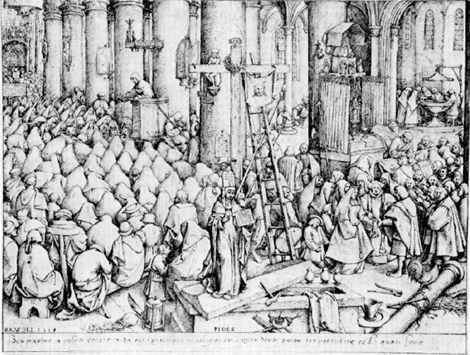
(1) Fides, Amsterdam, Rijksmuseum
| |
| |

(2) Spes, Berlin, Kupferstichkabinett, Staatliches Museum
| |
| |
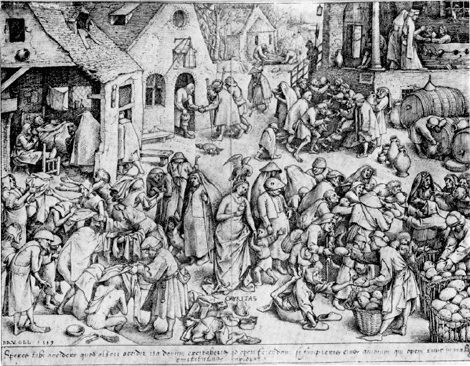
(3) Caritas, Rotterdam, Museum Boymans-van Beuningen
| |
| |

(4) Justitia, Brussels, Bibliothèque royale
| |
| |

(5) Detail of 4
| |
| |
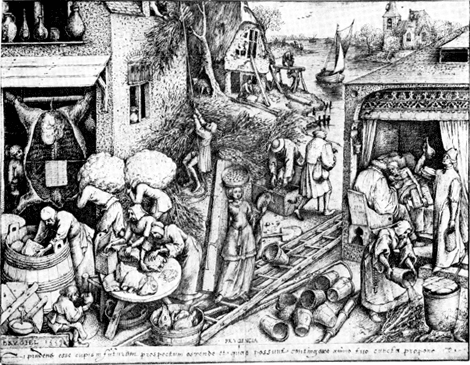
(6) Prudentia, Brussels, Musées Royaux des Beaux-Arts de Belgique
| |
| |
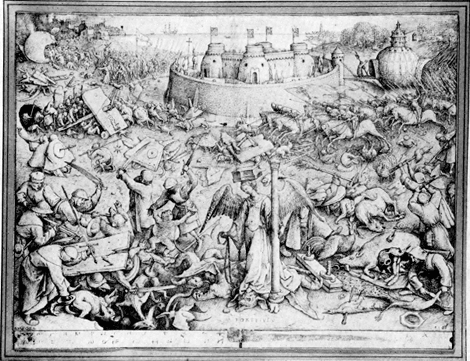
(7) Fortitudo, Rotterdam, Museum Boymans-van Beuningen
| |
| |
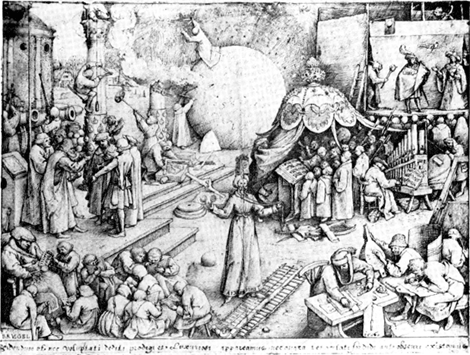
(8) Temperantia, Rotterdam, Museum Boymans-van Beuningen
| |
| |
| 5. | PRUDENCE may show seven types of material preoccupations (with food, health, money, firewood, agriculture, and trafficking on the seas). |
| 6. | FORTITUDE shows the Seven Deadly Sins. |
| 7. | TEMPERANCE shows the Seven Liberal Arts. |
To interpret Bruegel's series, the SEVEN VIRTUES as an exercise in paradox is to place it properly within the context of the artist's development, and to see it as a typical expression of sixteenth century philosophy. Here as elsewhere, Bruegel asserts that whichever way man turns he is bound by his nature to behave badly. The reason is, as Erasmus points out, that man confuses appearances and reality. He accepts man-made concepts of virtue which are based upon external and material show, but is unable either to comprehend or to attain the pure and spiritual perfection of virtue.
|
|